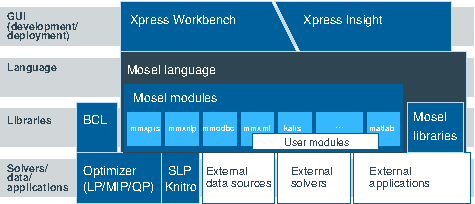Xpress product suite
Arising from different users' needs and preferences, there are several ways of working with the modeling and optimization tools that form the FICO Xpress Optimization product suite:
- High-level language: the Xpress Mosel language allows the user to define his models in a form that is close to algebraic notation and to solve them in the same environment. Mosel's programming facilities also make it possible to implement solution algorithms directly in this high-level language. Mosel may be used as a standalone program or through the Xpress Workbench development environment that provides, amongst many other tools, Mosel syntax and debugging support.
Via the concept of modules the Mosel environment is entirely open to additions; modules of the Xpress distribution include access to solvers (Xpress Optimizer for LP, MIP, and convex QP, Xpress Nonlinear, and Xpress Kalis), data handling facilities (e.g. via ODBC), access to system functions, graphing capabilities, distributed and remote computing functionality via the Mosel Distributed Framework, and also interfaces to statistics packages such as R or Matlab. In addition, via the Mosel Native Interface users may define their own modules to add new features to the Mosel language according to their needs (e.g. to implement problem-specific data handling, or connections to external solvers or solution algorithms). - Deployment as a web app: Mosel models can be deployed via Xpress Insight as multi-user web apps running locally, on-premises or on a cloud. Insight web apps are configured via a set of XML files that are packaged into an archive along with the Mosel model and its input data.
- Libraries for embedding: two different options are available for embedding mathematical models into host applications. A model developed using the Mosel language may be executed and accessed from a programming language environment (e.g. C, C++, Java, etc.) through the Mosel libraries; certain modules also provide direct access to their functions from a programming language environment.
The second possibility consists of developing a model directly in a programming language with the help of the model builder library Xpress-BCL. BCL allows the user to formulate his models with objects (decision variables, constraints, index sets) similar to those of a dedicated modeling language.
All libraries are available for C, C++, Java, C#, and Visual Basic (VBA). - Direct access to solvers: on the lowest, most immediate level, it is possible to work directly with the Xpress Optimizer or Xpress NonLinear in the form of a library or a standalone program. This facility may be useful for embedding Xpress Optimizer into applications that possess their own, dedicated matrix generation routines.
Advanced Xpress users may wish to employ special features of Xpress Optimizer that are not available through the different interfaces, possibly using a matrix that has previously been generated by Mosel or BCL.

Figure 2.2: Xpress product suite
Of the three above mentioned approaches, a high-level language certainly provides the easiest-to-understand access to Mathematical Programming. So in the first and largest part of this book we show how to define and solve problems with the Xpress Mosel language, and also how the resulting models may be embedded into applications using the Mosel libraries or Xpress Insight. We work with Mosel models in the graphical user interface Xpress Workbench, exploiting its facilities for debugging and solution analysis and display.
In the reminder of this book we show how to formulate and solve Mathematical Programming problems directly in a programming language environment. This may be done with modeling support from BCL or directly using the Optimizer library. With BCL, models can be implemented in a form that is relatively close to their algebraic formulation and so are quite easy to understand and to maintain. We discuss BCL implementations of the same example problems as used with Mosel.
The last part of this book explains how problems may be input directly into Xpress Optimizer, either in the form of matrices (possibly generated by another tool such as Mosel or BCL) that are read from file, or by specifying the problem matrix coefficient-wise directly in the application program. The facility of working directly with the Xpress Optimizer library is destinated at embedders and advanced Xpress users. It is not recommendable as a starting point for the novice in Mathematical Programming.
Note on product versions
The Mosel examples in this book have been updated to the FICO Xpress Optimization Release 8.7 (Mosel 5.0); Xpress Workbench screenshots have been taken with Release 8.7 (Workbench version 3.1.0). The Xpress Insight examples have been developed with Xpress Release 8.7 (Insight 4.51). The BCL examples are using BCL 4.8.11 that is distributed with Xpress Release 8.3. The Xpress Optimizer examples have equally been updated to the Xpress Release 8.3 (Optimizer 31.01.09). If the examples are run with other product versions the output obtained may look different. In particular, improvements to the algorithms or modifications to the default settings in the Optimizer may influence the behavior of the LP search or the shape of the MIP branching trees. The Xpress Workbench interface may also undergo slight changes in future releases as new features are added, but this will not affect the actions described in this book.
© 2001-2020 Fair Isaac Corporation. All rights reserved. This documentation is the property of Fair Isaac Corporation (“FICO”). Receipt or possession of this documentation does not convey rights to disclose, reproduce, make derivative works, use, or allow others to use it except solely for internal evaluation purposes to determine whether to purchase a license to the software described in this documentation, or as otherwise set forth in a written software license agreement between you and FICO (or a FICO affiliate). Use of this documentation and the software described in it must conform strictly to the foregoing permitted uses, and no other use is permitted.

